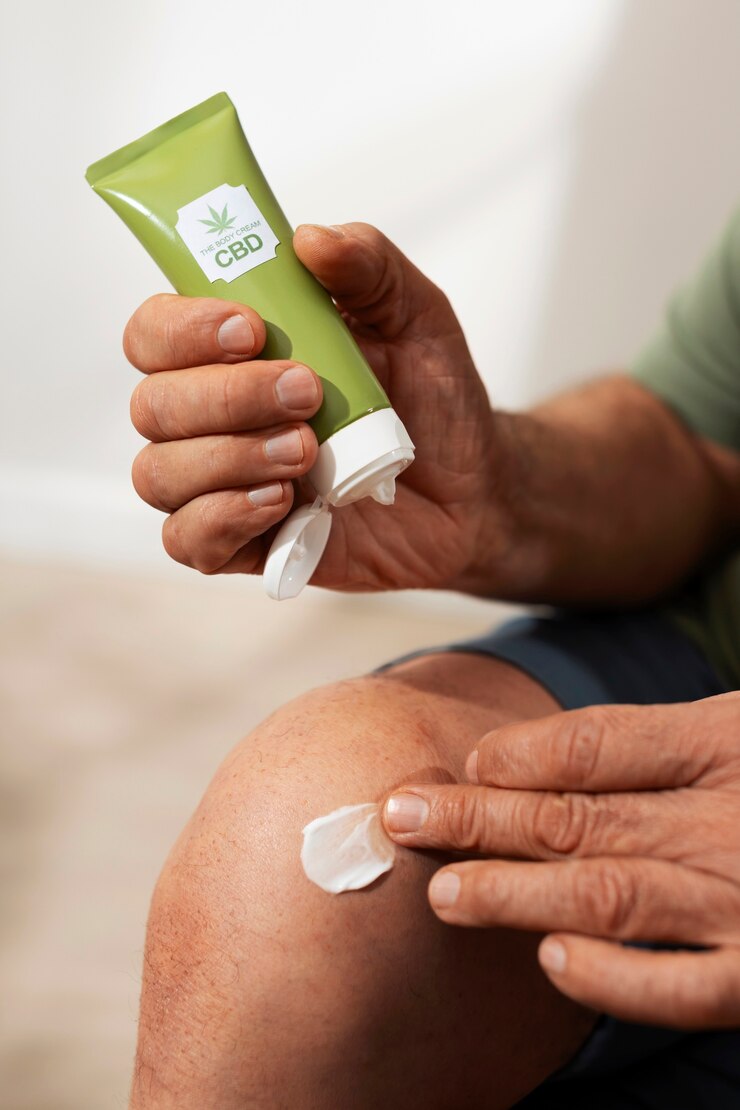The Science Behind CBD for Topical Pain Relief
Unlocking Localized Relief: The Science Behind CBD for Topical Pain Relief
In the ever-evolving world of wellness, CBD (cannabidiol) has emerged as a popular natural remedy for a variety of ailments, and its application in topical products for pain relief has garnered significant attention. From balms and creams to roll-ons and lotions, CBD-infused topicals are readily available in the UK, promising targeted relief for localized aches and discomfort. But what is the science behind this growing trend? How does applying CBD pain roll on to the skin actually translate to Topical Pain Relief? Let’s delve into the fascinating science that underpins the potential of CBD for soothing localized pain.
Understanding Pain Signals and the Skin’s Role
Before we explore the science of topical CBD, it’s crucial to understand how pain signals travel through the body and the role our skin plays in this process. Pain receptors, known as nociceptors, are located throughout the skin and other tissues. When these receptors detect a harmful stimulus (like injury or inflammation), they send electrical signals along nerve fibers to the spinal cord and then to the brain, where the sensation of pain is perceived.
The skin, our largest organ, acts as a protective barrier, but it also contains a complex network of cells, including immune cells and nerve endings, making it a potential target for Topical Pain Relief interventions.
CBD: A Primer on the Non-Psychoactive Cannabinoid
Cannabidiol (CBD) is one of over a hundred naturally occurring compounds found in the cannabis sativa plant. Unlike its well-known counterpart, THC (tetrahydrocannabinol), CBD is non-psychoactive, meaning it doesn’t produce the “high” associated with cannabis use. Instead, CBD interacts with the body’s endocannabinoid system (ECS), a complex network of receptors, enzymes, and endocannabinoids that plays a crucial role in regulating various physiological processes, including pain, inflammation, mood, and sleep.
The Endocannabinoid System (ECS) in the Skin: A Key Player in Topical Pain Relief

Interestingly, the endocannabinoid system isn’t just confined to the central nervous system; it’s also present in the skin. Skin cells, including keratinocytes, immune cells, and nerve endings, express cannabinoid receptors (primarily CB1 and CB2 receptors) and produce endocannabinoids. This localized ECS in the skin plays a vital role in maintaining skin homeostasis, regulating inflammation, and modulating pain and itch sensations, making it a prime target for Topical Pain Relief strategies.
How CBD Provides Topical Pain Relief: Unlocking the Mechanisms

When CBD is applied topically, it interacts directly with the cannabinoid receptors within the skin and underlying tissues in the localized area of application. While CBD doesn’t directly bind to CB1 and CB2 receptors like endocannabinoids or THC, it influences them and other components of the ECS in several ways that can contribute to Topical Pain Relief:
- Interaction with Local Cannabinoid Receptors: CBD can indirectly influence CB1 and CB2 receptors in the skin, potentially reducing the transmission of pain signals in the applied area.
- Modulation of Inflammation: Inflammation is a significant contributor to many types of pain. Research suggests that CBD possesses anti-inflammatory properties by interacting with various pathways involved in the inflammatory response within the skin and underlying tissues. By reducing local inflammation, topical CBD can help alleviate pain associated with conditions like arthritis or muscle strains.
- Influence on Pain Perception: CBD may also interact with other receptors in the skin, such as TRPV1 receptors, which are involved in pain and temperature perception. This interaction could potentially alter how pain signals are processed at the local level, contributing to Topical Pain Relief.
- Potential Impact on Nerve Endings: Some research suggests that topical CBD may interact with nerve endings in the skin, potentially desensitizing them and reducing the sensation of pain, particularly in cases of neuropathic pain.
The Role of Carrier Oils and Other Ingredients in Topical Pain Relief
The effectiveness of CBD topicals isn’t solely reliant on CBD itself. The carrier oils and other ingredients in the formulation play a crucial role in enhancing absorption and providing additional benefits for Topical Pain Relief. Common carrier oils like coconut oil, hemp seed oil, and shea butter can help the CBD penetrate the skin barrier. Additionally, many topical CBD products contain other beneficial ingredients like menthol, camphor, arnica, and essential oils, which have their own analgesic, anti-inflammatory, or soothing1 properties, working synergistically with CBD to provide enhanced relief.2
Scientific Evidence Supporting Topical Pain Relief with CBD
While more large-scale human3 clinical trials are needed, a growing body of preclinical and some human studies supports the potential of topical CBD for pain relief:
- Arthritis Pain: Studies have shown that topical CBD can reduce pain and inflammation associated with arthritis in animal models, and some human studies have reported similar benefits for osteoarthritis and rheumatoid arthritis.
- Neuropathic Pain: Research suggests that topical CBD may be effective in reducing neuropathic pain, a type of chronic pain caused by nerve damage.
- Muscle Soreness and Exercise-Induced Pain: Anecdotal evidence and some limited studies indicate that topical CBD can help alleviate muscle soreness and pain after exercise.
- Inflammatory Skin Conditions: While not directly pain relief, CBD’s anti-inflammatory properties can indirectly reduce pain associated with inflammatory skin conditions like eczema and psoriasis.
Types of Pain That May Benefit from Topical Pain Relief with CBD
Based on current research and anecdotal evidence, topical CBD may be particularly beneficial for:
- Localized Joint Pain: Such as pain in the knees, hands, or elbows due to arthritis.
- Muscle Soreness and Strains: Pain resulting from exercise, overuse, or minor injuries.
- Localized Nerve Pain: Such as peripheral neuropathy or sciatica.
- Inflammatory Skin Conditions: Pain and discomfort associated with conditions like eczema or psoriasis.
- Back and Neck Pain: When the pain is localized to specific areas.
Factors Affecting the Effectiveness of Topical Pain Relief with CBD
Several factors can influence how effective a topical CBD product is for pain relief:
- CBD Concentration: Higher concentrations of CBD may lead to more pronounced effects.
- Product Formulation: The quality of the carrier oils and the presence of other beneficial ingredients can significantly impact absorption and efficacy.
- Application Method: Applying the product directly to the affected area and gently massaging it in can enhance absorption.
- Individual Differences: Factors like skin thickness, the severity of the pain, and individual metabolism can affect how well topical CBD works.
- Frequency of Application: Consistent application throughout the day may be necessary for sustained relief.
Choosing High-Quality CBD Topicals in the UK for Topical Pain Relief
With the increasing popularity of CBD topicals in the UK, it’s crucial to choose high-quality products from reputable brands. Look for:
- Third-Party Lab Testing: Ensure the product has been independently tested to verify the CBD content and check for contaminants. Look for a Certificate of Analysis (COA).
- Clear Ingredient List: Check for high-quality carrier oils and other beneficial ingredients. Be wary of products with excessive artificial ingredients or fragrances.
- Reputable Brands: Research the brand’s reputation and read customer reviews. Choose brands that are transparent about their sourcing and manufacturing processes.
- UK Compliance: Ensure the product complies with UK CBD regulations regarding THC content (less than 0.2%).
Conclusion: Embracing Targeted Relief with the Science of Topical CBD
The science behind CBD for Topical Pain Relief is promising, highlighting the potential of this natural compound to interact with the skin’s endocannabinoid system and alleviate localized aches and discomfort. While more research is always beneficial, the existing evidence suggests that topical CBD can be a valuable tool for managing various types of pain, offering a targeted and potentially gentler approach compared to systemic medications. By understanding the science and choosing high-quality products, individuals in the UK can explore the benefits of topical CBD for finding localized and effective pain relief.
Frequently Asked Questions (FAQs)

1. How does CBD applied topically actually penetrate the skin to provide Topical Pain Relief?
CBD molecules are relatively large, and the skin is designed to be a barrier. However, when formulated in topical products, CBD can penetrate the outer layers of the skin (epidermis) and reach the dermis, where many cannabinoid receptors, nerve endings, and immune cells are located. The effectiveness of penetration depends on factors like the concentration of CBD, the formulation of the product (including the type of carrier oils), and whether penetration enhancers are included. Massaging the product into the skin can also help facilitate absorption for better Topical Pain Relief.
2. Is the CBD absorbed from topical products enough to have systemic effects throughout the body, or is it purely for Topical Pain Relief?
Generally, the absorption of CBD from topical products into the bloodstream is minimal. This means that topical CBD primarily provides localized relief in the area where it is applied, making it ideal for Topical Pain Relief. While some very small amounts of CBD might enter the systemic circulation, it’s usually not enough to produce body-wide effects like those experienced with oral CBD products. This localized action is often preferred when the pain is concentrated in a specific area.
3. What types of pain are best suited for Topical Pain Relief using CBD, according to the science?
Based on current scientific understanding and research, topical CBD appears to be most effective for localized pain conditions. This includes pain associated with=Osteoarthritis: Targeting specific joints affected by arthritis.
Muscle Soreness and Strains: Applying directly to sore or strained muscles.
Peripheral Neuropathy: Addressing nerve pain in localized areas like hands or feet.
Inflammatory Skin Conditions: Reducing pain and inflammation associated with conditions like eczema.
4. Are there any potential side effects of using CBD for Topical Pain Relief that the science has identified?
While generally considered safe, some individuals may experience mild side effects from topical CBD products. The most common side effects are localized skin reactions at the application site, such as redness, itching, or irritation. These reactions are often due to other ingredients in the product rather than the CBD itself. The science indicates that systemic side effects from topical CBD are rare due to the minimal absorption into the bloodstream. It’s always recommended to perform a patch test on a small area of skin before applying a new topical CBD product more widely to check for any potential allergic reactions or sensitivities for safe and effective Topical Pain Relie







